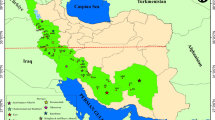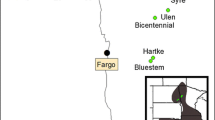Abstract
Although genotypic and phenotypic markers are used to describe genetic diversity, describing patterns of variationattributable to geographic differentiation is complex.We examined concordance between morphologic and RAPDmarker classification of 33 wild red clover populations collected from the Caucasus Mountains, Russia andcompared how morphologic and RAPD markers differed in their correspondence to collection site attributes.Wealso examined if wild red clover populations collected from sites located in areas more conducive to gene flow (i.e.adjacent to roads, or drainage systems) had the same concordance between morphologic and RAPD markers aspopulations collected from sites less conducive to gene flow.We measured 15 morphologic traits in a commongarden and carried out a Random Amplified Polymorphic DNA (RAPD) analysis. There was a significantdifference among the 33 populations for 14 out of 15 morphological traits. Morphology clustered the populationsinto classes that corresponded to three climate regimes. Classification schemes generated by morphologic andRAPD data did not coincide. Morphologic data corresponded with site data for populations collected at all sites.RAPD data corresponded to site data for only those populations collected at sites not conducive to gene flow. Apopulation's adaptation to collection site needs to be considered in using neutral markers to effectivelydiscriminating geographic differentiation.We discuss the practical lessons of this study on the effective collection,conservation and use of plant genetic resources.
Similar content being viewed by others
References
Benjamini Y. and Hochberg Y. 1995. Controlling the false discov-ery rate. a practical and powerful approach to multiple testing. Journal of the Royal Statistical Society 57: 289–300.
Doyle J.J. and Doyle J.L. 1989. Isolation of plant DNA from fresh tissue. Focus 12: 13–15.
Godt M.W. and Hamrick J.L. 1996. Genetic diversity and mor-phological differentiation in Liatri helleri (Asteraceae), a threat-ened plant species. Biodiversity and Conservation 5: 461–471.
Greene S.L., Hart T.C. and Afonin A. 1999a. Using geographic information to acquire wild crop germplasm for ex situ collec-tions. I. Map Development and Use. Crop Science 39: 836–842.
Greene S.L., Hart T.C. and Afonin A. 1999b. Using geographic information to acquire wild crop germplasm for ex situ collec-tions. II. Post collection analysis. Crop Science 39: 843–849.
Greene S.L. and Hart T.C. 1999. Implementing a geographic analysis in germplasm conservation. In: Greene S.L. and Guarino L. (eds), Linking Genetic Resources to Geography. Strategies for Conserving Crop Biodiversity. CSSA, Madison, WI, Special Publication No 27, pp. 25–38.
Heaton H.J., Whitkus R.R. and Gomez-Pompa A. 1999. Extreme ecological and phenotypic differences in the tropical tree chicozapote (Manilkara zapota (L.) P. Royen) are not matched by ingenetic divergence. a random amplified polymorphic DNA (RAPD) analysis. Molecular Ecology 8: 627–632.
Hedrick P.W. 1986. Genetic polymorphisms in heterogeneous enutilize vironments. a decade later. Annual Review of Ecological Systematics 17: 535–566.
Johns M.A., Skroch P.W., Nienhuis J., Hinrichsen P., Bascur G. and Munoz-Schick C. 1997. Gene pool classification of common bean landraces from Chile based on RAPD and morphological data. Crop Science 37: 605–613.
Johnson D.E. 1998. Applied Multivariate Methods for Data Analysts. Brooks/Cole Publishing Company, CA.
Jordano P. and Godoy A. 2000. RAPD variation and population genetic structure in Prunus mahaleb (Rosaceae), an animal-dispersed tree. Molecular Ecology 9: 1293–1305.
Linhart Y.B. and Grant M.C. 1996. Evolutionary significance of local genetic differentiation in plants. Annual Review of Ecological Systematics 27: 237–277.
Li Y.C., Fahima T., Beiles A., Korel A.B. and Nevo E. 1999. Microclimatic stress and adaptive DNA differentiation in wild emmer wheat, Triticum dicoccoides. Theoretical and Applied Genetics 98: 873–883.
Loveless and Hamrick 1984. Ecological determinants of genetic structure in plant populations. Ann. Rev. Ecol. Syst. 15: 65–95.
Lynch M. and Milligan B.G. 1994. Analysis of population genetic structure with RAPD markers. Molecular Ecology 3: 91–99.
Manly B.F.J. 1994. Multivariate Statistical Methods. a primer. 2nd edn. Chapman and Hall, New York.
Mantel N.A. 1967. The detection of disease clustering and a generalized regression approach. Cancer Research 27: 209–220.
Morris J.B. and Greene S.L. 2001. Defining a multiple-use germ-Germplasm collection for the genus Trifolium. Crop Science 41: 893–901.
Müller-Schärer H. and Fischer M. 2001. Genetic structure of the annual weed Senecio vulgaris in relation to habitat type and population size. Molecular Ecology 10: 17–28.
Nebauer S.G., Del Castillo-Agudo L. and Segura J. 1999. RAPD variation within and among natural populations of outcrossing willow-leaved foxglove (Digitalis obscura L.). Theoretical and Applied Genetics 98: 985–994.
Rohlf F.J. 1993. NTSYS: Numerical Taxonomy and Multivariate Analysis System, v. 2.02k. Exeter Software, Setauket, NewYork.
Romesburg H.C. 1990. Cluster Analysis for Researchers. Krieger Publishing Company, Malabar, Florida.
Semagn K., Bjornstad A., Stedje B. and Bekele E E. 2000. Comtissue. parison of multivariate methods for the analysis of genetic resources and adaptation in Phytolacca dodecandra using RAPD. Theoretical and Applied Genetics 101: 1145–1154.
Slatkin 1987. Gene flow and the geographic structure of natural populations. Science 236: 787–792.
Smith R.R., Taylor N.L. and Bowley S.R. 1985. Red Clover. In: Taylor N.L. (ed.), Clover Science and Technology. ASA Special Publication 25, Madison, WI, pp. 471–490.
Steiner J.J., Beuselinck P.R., Greene S.L., Kamm J.A., Kirkbride J.H. and Roberts C.A. 2001. A description and interpretation of the NPGS Trefoil core subset collection. Crop Science 41: 1968–1980.
Steiner J.J. and Garcia de los Santo G. 2001. Adaptive ecology of Lotus corniculatus L. genotypes. I. Plant morphology and RAPD marker characterizations. Crop Science 41: 552–563.
Author information
Authors and Affiliations
Rights and permissions
About this article
Cite this article
Greene, S., Gritsenko, M. & Vandemark, G. Relating Morphologic and RAPD Marker Varlation to Collection Site Environment in wild Populations of Red Clover (Trifolium Pratense L.). Genetic Resources and Crop Evolution 51, 643–653 (2004). https://doi.org/10.1023/B:GRES.0000024655.48989.ab
Published:
Issue Date:
DOI: https://doi.org/10.1023/B:GRES.0000024655.48989.ab




